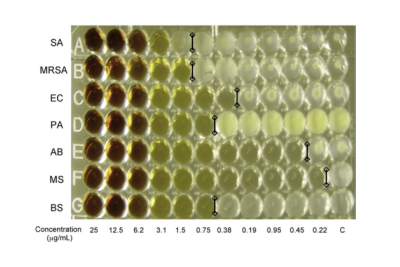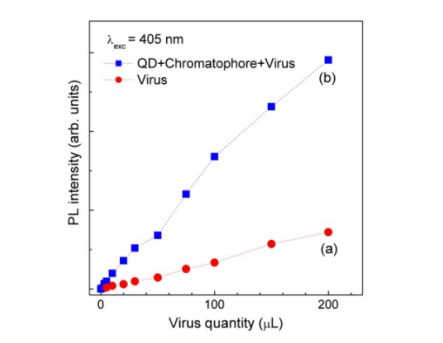CD Bioparticles is a leading manufacturer and supplier of various drug delivery products, including metal nanostructures, biomacromolecules, synthetic polymer and biopolymers and lipid system, for R&D and commercialization in a variety of application areas. We also have developed mature technology platforms for drug delivery, such as inorganic nanomaterials, biomacromolecules, polymeric and lipid system. In addition, we can offer a wide range of custom services including drug delivery nanoparticles formulation, bioparticles analysis and characterization, and drug targeting strategy. We are dedicated to providing the most comprehensive list of products and fit-for-purpose custom analysis and synthesis services to academia as well as industrial researchers and assay developers all around the world.
In the past decade, people have paid much attention to the development of antimicrobial biomaterials based on metal nanoparticles, especially silver nanoparticles (SNPs). Since SNPs have antibacterial, antifungal, anti-viral, and anti-inflammatory properties, people have applied them to many medical products. It has been demonstrated that applying SNPs is very effective in the prevention and treatment of bacterial infections. In particular, SNPs can avoid bacterial infections from medical devices. In other words, the antibiotic coating of devices has a great effect on reducing device-related infection.
Due to the increasing incidence of healthcare-associated infections (HCAIs), people prefer to produce healthcare or medical devices with auto-sanitizing property. The application of NPs as active components in composite materials to replace conventional chemical products (e.g. ethanol and bleach) presents a long-lasting bactericidal effect and has no toxicity to the human body. As a result, with the urgent need to prevent HCAIs, it is expected that the application of SNPs in medical devices, equipment and textiles will further expand.
Generally, SNPs exert the antimicrobial effect by releasing free metal Ag+ ions (Figure 1). However, Ag+ ions can be easily sequestered by chloride, phosphate, proteins and other cellular components. As a result, SNPs with less susceptible to sequestration are more ideal for effective delivery. Although the biological effect of NPs is largely unproven, many recent studies support the theory that the combination of precipitated silver complexes and organic silver compounds causes cytotoxic effects, rather than free silver ions. According to these studies, the antibacterial ability of silver is due to the generation of silver ions in the aqueous solution and their binding with the proteins on the bacterial cell membrane, accompanying with inhibiting cell respiration and reproduction. In addition, the bioavailability of ions in dissolution or transport and interaction with biological targets may be affected by the particle size, free surface area, shape, and charge.

Figure 1. MICs of nanoparticles against bacterial strains. Serial dilutions of nanoparticles no. 1 were exposed to bacterial strains. Only nanoparticles no. 1 and selected bacterial strains are shown as an example of MIC determination. MIC, minimum inhibitory concentration; SA, Staphylococcus aureus; MRSA, methicillin-resistant Staphylococcus aureus; EC, Escherichia coli; PA, Pseudomonas aeruginosa; AB, Acinetobacter baumanii; MS, Mycobacterium smegmatis; BS, Bacillus subtilis. C, No nanoparticles added. Black bars denote the MICs for this specific experiment. (Martinez-Gutierrez, et al. (2010). Synthesis, characterization, and evaluation of antimicrobial and cytotoxic effect of silver and titanium nanoparticles. Nanomedicine: Nanotechnology, Biology and Medicine, 6(5), 681–688)
When applying SNPs coating to medical devices, the toxicity issue should not be ignored. Toxicity means the adverse effects on organisms upon exposure to silver. But this toxicity (e.g. disinfection or sterilization) must show on the specific type of organism, which can be interpreted as a positive outcome such as antibacterial and antiviral. If it shows unintended or undesired impacts on other organisms, then such toxicity may be interpreted as a potential hazard. In other words, the toxicity of an ideal antimicrobial candidate should be selective, namely being antibacterial at a given concentration but no toxic to humans. So, concerns have been raised currently regarding the potential toxicities of SNPs.
In addition to bactericidal effect, NPs are also applied in biosensors (Figure 2). Quantum dots (QDs) are NPs of a few hundred atoms. They can absorb light at a wide range of wavelengths but radiate monochromatic light of a wavelength depending on the size of the crystals. This procedure is controllable. Furthermore, due to its inorganic material property, QDs are more durable in the body than organic counterparts. For example, the surface area of cadmium telluride was conducive to functionalization and its conductive properties promoted the oxidation of the thiocholine-acetylcholinesterase complex, thus increasing the sensitivity of biosensors.

Figure 2. PL intensity of H5N1 avian influenza virus (a) and of biosensor composed of all the CdTe/CdS QDs, chromatophore and H5N1 avian influenza virus under detection (b). PL, photoluminescence. (Nguyen, T. H., et al. (2012). Fluorescence biosensor based on CdTe quantum dots for specific detection of H5N1 avian influenza virus. Advances in Natural Sciences: Nanoscience and Nanotechnology, 3(3), 035014)
CD Bioparticles is specialized in the development of drug delivery systems and customizing nanocarriers for drug delivery utilizing our core technologies. With our high-quality products and services, the efficacy of your drug delivery can be tremendously improved.
We offer custom synthesis of polymer microspheres and nanoparticles for medical devices. Clients may select the material type, particle size, size distribution, color dye, fluorescent dye, and/or surface functional groups such as carboxyl or amine groups. We enable you to make wise decisions on all components of the antibody-drug conjugate (ADC) structure so that the optimal candidate is identified for your target of interest in terms of stability, off-target toxicity, and efficacy. Besides, methodologies developed to produce the ADC are simple, scalable and reproducible and ultimately suitable for large-scale manufacture.
References:
1. Fernando, S. S. N., Gunasekara, T. D. C. P., & Holton, J. (2018). Antimicrobial Nanoparticles: applications and mechanisms of action. Sri Lankan Journal of Infectious Diseases, 8(1).
2. Polívková, M., Hubáček, T., Staszek, M., Švorčík, V., & Siegel, J. (2017). Antimicrobial treatment of polymeric medical devices by silver nanomaterials and related technology. International Journal of Molecular Sciences, 18(2), 419.
3. Marassi, V., Di Cristo, L., Smith, S. G. J., Ortelli, S., Blosi, M., Costa, A. L., Prina-Mello, A, et al. (2018). Silver nanoparticles as a medical device in healthcare settings: a five-step approach for candidate screening of coating agents. Royal Society Open Science, 5(1), 171113.
1. Download the template.
2. Enter product information on the template (maximum number of products: 200).
3. Load the file using selector below.
1. Download the template.
2. Enter product information on the template (maximum number of products: 200).
3. Load the file using selector below.